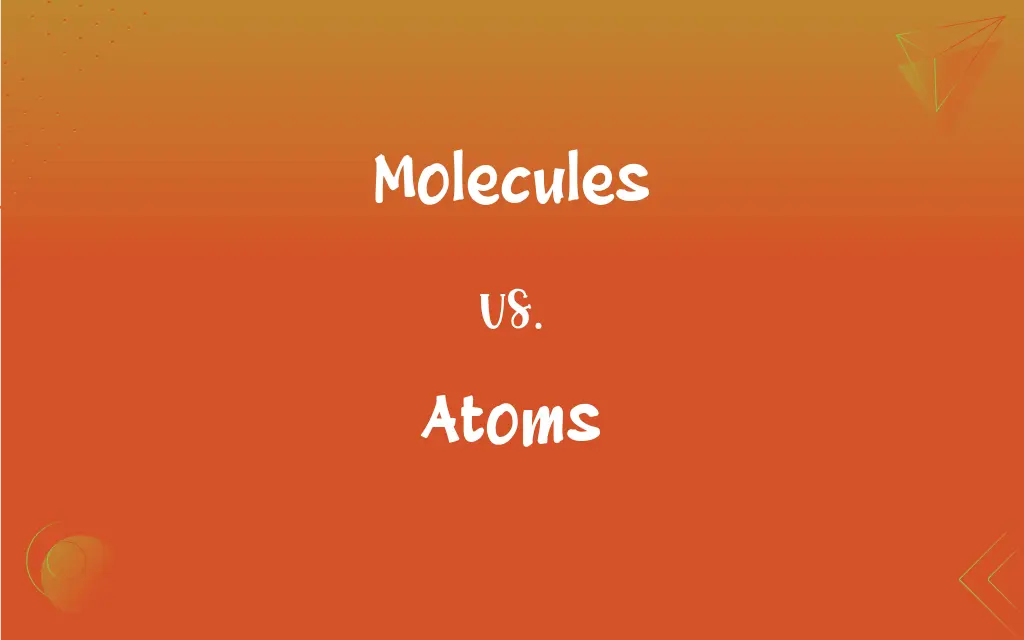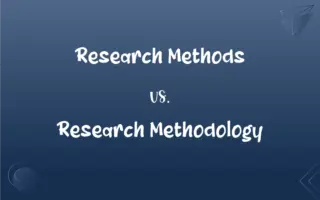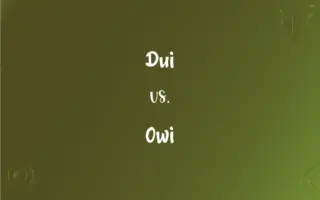Molecules vs. Atoms: What's the Difference?
Edited by Janet White || By Harlon Moss || Updated on July 11, 2024
Molecules are formed when two or more atoms bind together. Atoms are the basic units of elements.

Key Differences
Molecules are composed of two or more atoms chemically bonded together. They represent the smallest unit of a chemical compound that can take part in a chemical reaction. Atoms, in contrast, are the basic units of matter, consisting of a nucleus of protons and neutrons, surrounded by electrons.
Molecules can vary significantly in size and complexity, ranging from simple diatomic molecules like oxygen (O₂) to large macromolecules like proteins. Atoms, however, are relatively small and singular, each representing a unique element on the periodic table, such as hydrogen (H) or carbon (C).
The bonds within molecules can be covalent or ionic, involving the sharing or transferring of electrons, respectively. Atoms themselves do not form such bonds until they interact with other atoms, highlighting their reactive nature to achieve stability.
Molecular behavior and properties depend on the type and arrangement of atoms within them. For example, water (H₂O) has unique properties due to the specific bonding of hydrogen and oxygen atoms. On the other hand, the behavior of atoms is determined by their subatomic particles, particularly the number of protons which defines the element.
Chemical reactions involve the breaking and forming of bonds between atoms to create new molecules. While atoms themselves are conserved in reactions, the molecules they form can change, emphasizing the dynamic nature of molecular chemistry versus the more static identity of atoms.
ADVERTISEMENT
Comparison Chart
Basic Definition
Groups of two or more atoms bonded together
Smallest unit of an element, composed of protons, neutrons, and electrons
Existence
Can exist as stable entities due to atomic bonding
Can exist independently or as ions
Involvement in Chemical Reactions
Engage in chemical reactions by forming and breaking bonds
Participate by altering electron configurations to form bonds
Structural Complexity
Can be simple or complex depending on atomic arrangement
Maintain a consistent structure with a central nucleus and orbiting electrons
Example
H2O (water) consists of 2 hydrogen atoms and 1 oxygen atom
Oxygen atom, represented as O, has 8 protons
ADVERTISEMENT
Molecules and Atoms Definitions
Molecules
Molecules exhibit distinct physical and chemical properties.
Water molecules have a boiling point of 100 degrees Celsius at standard pressure.
Atoms
Atoms are characterized by their atomic number, which is determined by the number of protons.
Carbon atoms have an atomic number of 6, indicating six protons.
Molecules
Molecules can consist of identical or different atoms.
Oxygen molecules (O2) consist of two identical oxygen atoms.
Atoms
Atoms are the fundamental building blocks of matter.
Everything in the world is made up of atoms, from mountains to animals.
Molecules
Molecules can vary in size and complexity.
DNA molecules are complex structures encoding genetic information.
Atoms
Atoms can exist independently or combine with other atoms.
Noble gases like helium consist of single atoms that rarely combine with others.
Molecules
Molecules are groups of atoms bonded together.
Water molecules are composed of two hydrogen atoms and one oxygen atom.
Atoms
Atoms can combine to form molecules through chemical bonds.
Oxygen atoms bond together to form O2, an oxygen molecule.
Molecules
Molecules participate in chemical reactions by forming and breaking bonds.
In photosynthesis, carbon dioxide and water molecules react to form glucose and oxygen molecules.
Atoms
Atoms consist of protons, neutrons, and electrons.
Hydrogen atoms contain one proton and one electron, but no neutrons.
Molecules
The smallest particle of a substance that retains the chemical and physical properties of the substance and is composed of two or more atoms; a group of like or different atoms held together by chemical forces.
Atoms
A part or particle considered to be an irreducible constituent of a specified system.
Molecules
A small particle; a tiny bit.
Atoms
The irreducible, indestructible material unit postulated by ancient atomism.
Molecules
Plural of molecule
Atoms
An extremely small part, quantity, or amount.
Atoms
The smallest unit of an element, having all the characteristics of that element and consisting of a very small and dense central nucleus containing protons and neutrons, surrounded by one or more shells of orbiting electrons. Atoms remain undivided in chemical reactions except for the donation, acceptance, or exchange of valence electrons.
Atoms
This unit regarded as a source of nuclear energy.
Atoms
Plural of atom
FAQs
What determines the type of atom?
The atomic number, which is the number of protons, determines the type of atom.
What is an atom?
An atom is the smallest unit of an element, comprising protons, neutrons, and electrons.
What is a molecule?
A molecule is a group of two or more atoms bonded together.
How are molecules formed from atoms?
Molecules are formed when atoms bond together through covalent or ionic bonds.
Can molecules be seen with the naked eye?
No, molecules are typically too small to be seen without specialized instruments.
Can atoms lose or gain electrons?
Yes, atoms can lose or gain electrons, forming ions.
What is a molecular formula?
A molecular formula shows the number and type of atoms in a molecule.
Can atoms of different elements have the same number of electrons?
Yes, through ionization or sharing, different atoms can have equal electron numbers.
How do atoms bond in a molecule?
Atoms bond through sharing (covalent bond) or transferring (ionic bond) electrons.
Can molecules contain more than two atoms?
Yes, molecules can contain anywhere from two to thousands of atoms.
What is the smallest atom?
Hydrogen is the smallest atom, with one proton and one electron.
Are molecules always neutral?
Typically, molecules are neutral, but they can have a net charge, becoming ions.
What particles are found in the nucleus of an atom?
Protons and neutrons are found in an atom's nucleus.
What is the largest known molecule?
DNA is among the largest known molecules, with millions of atoms.
Can atoms exist independently?
Yes, atoms can exist independently, especially noble gases.
Do atoms and molecules have mass?
Yes, both atoms and molecules have mass, determined by their protons and neutrons.
Are all atoms of an element identical?
Yes, all atoms of a specific element have the same number of protons.
Can molecules be broken down into atoms?
Yes, molecules can be broken down into individual atoms through chemical reactions.
What is the role of electrons in an atom?
Electrons occupy the outer regions of an atom and are involved in chemical bonding.
Can molecules be formed from atoms of the same element?
Yes, molecules can be formed from identical atoms, like O2, or different atoms, like H2O.
About Author
Written by
Harlon MossHarlon is a seasoned quality moderator and accomplished content writer for Difference Wiki. An alumnus of the prestigious University of California, he earned his degree in Computer Science. Leveraging his academic background, Harlon brings a meticulous and informed perspective to his work, ensuring content accuracy and excellence.
Edited by
Janet WhiteJanet White has been an esteemed writer and blogger for Difference Wiki. Holding a Master's degree in Science and Medical Journalism from the prestigious Boston University, she has consistently demonstrated her expertise and passion for her field. When she's not immersed in her work, Janet relishes her time exercising, delving into a good book, and cherishing moments with friends and family.
































































